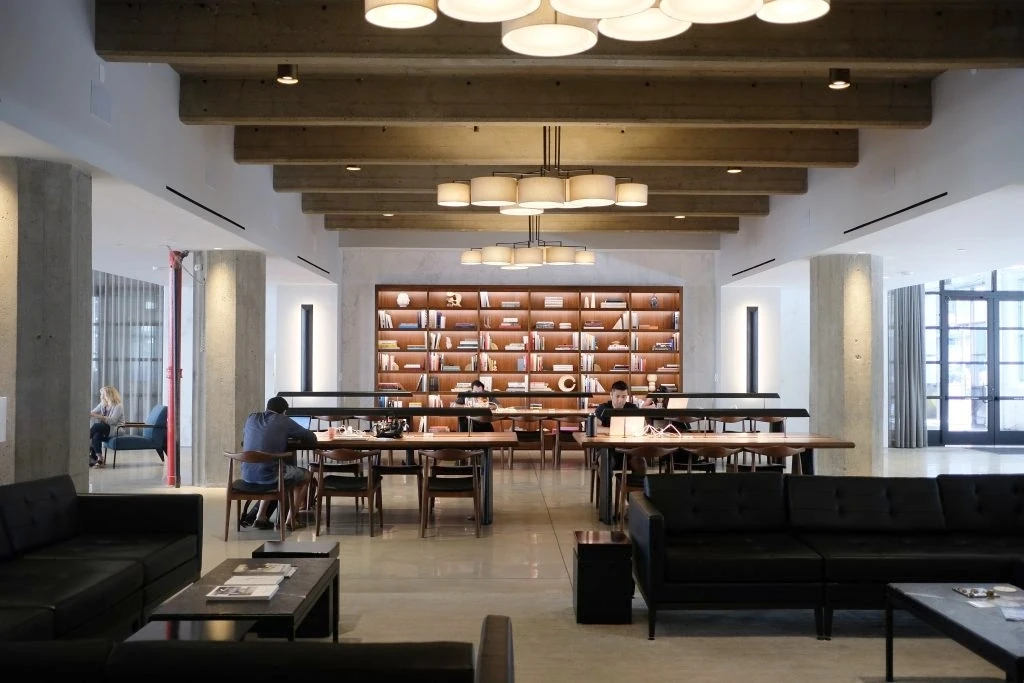
Our team has been working on creating the very best coworking space management software since 2016.
In that time, we’ve come to understand just how important space management is when it comes to the success of a coworking business.
We’ve also seen how easily operators can become overwhelmed when it comes to how to manage a coworking space. There is a lot to think about, from administrative tasks to membership management to what space management software you’ll choose.
In this article, we’ll walk you through our best tips for how to manage a coworking space, including how to manage a team, how to keep your community happy, and how to leverage management software to improve the entire experience.
By the end of this article, you’ll have all of the knowledge you’ll need to successfully manage your space. Let’s get started!
The fundamentals of coworking space management
There are two key elements of managing a coworking space: space management (operations) and people management.
Space management (operations) is how you manage your day-to-day business operations. This includes things like:
- Processing billing and payments
- Managing check-ins
- Cleaning the space
- Refilling coffee
- Buying office supplies
When most people think of managing a coworking space, they think of managing the operations.
People management is how you manage your members and your team. With people management, you’ll want to answer questions like:
- Are your members happy and taken care of?
- Do you know how to handle member disturbances when they occur?
- Does your team feel supported?
- Is your team set up to do their best work?
If you’re a small team of one or two people (as so many of our clients are), you may be wondering how you can get all of this done by yourself.
The good news is, implementing the right coworking tech stack, including a robust coworking space management software, will help you be able to do everything you need in your space – and more.
How to manage a coworking space with coworking space management software

Technology is an essential part of efficiently managing your coworking space. If you want to save time on manual work, optimize your decision making, and grow your business, you’ll need a solid coworking technology ecosystem in place with coworking management software at the center.
Therefore, the very first step in your coworking journey should be selecting the right space management software for your business.
Look for a platform and company that aligns with your business model and your values. We wrote an entire guide to choosing the best coworking software – you can refer to that article for a detailed guide on the best platforms on the market.
Let’s take a closer look at how to manage your coworking space operations, members, and team efficiently, as well as how to use coworking space management software along the way.
Building a coworking tech stack? Download our eBook on how to build a coworking technology ecosystem.
1. How to manage your coworking space operations
Managing your operations efficiently is paramount to ensuring your business runs smoothly and can scale. It is also a primary opportunity for automation.
Let’s break down a few high level tips for successful coworking space operations management.
Automate as many daily operations as possible
The modern coworking space is autonomous. Introducing automation into your space will help you:
- Make your business operations more efficient
- Save time and money on staffing, mundane tasks, and more
- Improve the security of your space
- Expand your hours of operation
Start by looking for repetitive tasks in your space like billing, invoicing, and bookings, and see how you can make them more automatic – hint: this is where coworking technology can become hugely beneficial.
We wrote a guide to automated coworking spaces for Coworking Resources if you’d like to learn more about creating autonomous coworking spaces. At the core will be selecting the right system of tools to enable autonomy – think, coworking software like Optix, an access control system like Kisi, and a payment gateway like Stripe – and linking them all together.
Which brings us to our next point.
Integrate your technology platforms
Modern coworking space management is built upon creating an integrated tech stack. It’s not about having a bag of tools – rather the best space operators are dedicated to bringing these tools together to improve their business strategy.
Not only can integrating your tech stack be extremely helpful for streamlining operations, it can also reduce operational costs, create a better experience for potential members, and generate new growth opportunities.
When it comes to building an integrated coworking technology system, here is what we recommend:
- Start with what you need your technology to accomplish (your goals)
- Select the right solutions to fit your business
- Integrate your solutions with one another using the documentation provided by the software platforms you’re using
- Keep an eye on the integrations and troubleshoot as needed.
This page on integrations will give you more information on integrating coworking technology.
Develop fool-proof systems and processes from the beginning
Technology is only as good as the systems behind it. Spend some time setting up solid operational systems and processes at the very beginning of your coworking journey to avoid headaches down the road.
This could mean:
- Using a project management tool like Asana, Trello, or ClickUp to track tasks across team members
- Creating spreadsheets to help you keep track of what needs to get done and when
- Setting aside an hour every Sunday night to map out essential tasks for the week
Figure out what you want to accomplish on a yearly, monthly, weekly, and daily basis and create a system that helps bring you closer to your goals.
2. How to manage members in coworking spaces

Streamlining operations is a significant part of managing a coworking space. Not to be outdone however, is the importance of managing people, including your members and your employees.
Taking care of your members is the building block for a healthy and vibrant community. Here are some tips for how to do just that effectively.
Set clear rules and expectations
The best thing you can do for member management is set clear rules and expectations from the beginning and communicate them effectively. This is often referred to as your coworking house rules.
Your house rules are a 1-3 page document that outlines:
- Basic need-to-knows (hours, parking, payments, etc.)
- How to access amenities in the space (using a printer, using an access control system, etc.)
- Rules and regulations (dog policy, guests, coming in after-hours, etc.)
When creating this document, make sure it is accessible in multiple places at any given time including on your website, emailed to your members directly during their onboarding, and in your space itself.
You can also link your house rules in your white-labeled app or space management software so members can easily access them on their personal device from any location.
Have a plan for when there is a disturbance (and clear consequences)
Dealing with a disturbance is almost always going to be uncomfortable. Having a plan will help mitigate this discomfort.
Have some general guidelines on how to handle common disturbances internally as a team. Here are a few examples of things you’ll want to have an action plan for:
- A member is behaving in a way that repeatedly disturbs another member or makes another member feel uncomfortable
- A member behaves hostile towards you or a member of your team
- A member has not paid their bill for some time
Map out a few of the most common member situations that can happen in your space and have a specific plan of how to handle them. This will make both you and your team feel significantly more prepared.
Be sure to outline any consequences in your house rules as well, and enforce them when disturbances occur. The enforcement of clearly outlined rules will help ensure less issues in the future.
Collect member feedback often
Member feedback is invaluable to improving your coworking space. A great coworking member survey can help you get all of the information that you need.
Develop a habit of asking your members how they feel about their experience. This can help you be proactive in your member management strategy and become an effective leader.
You can schedule surveys to occur at the one, six, and twelve-month membership mark to receive feedback on the employee experience at various stages. Use your management software and send a push notification to your members encouraging them to take the survey at predefined intervals to help automate this process for you.
3. How to manage your coworking space employees

Finally, it’s worth thinking about how you will manage your team of coworking space managers to run a successful coworking business. Here are a few best practices to help you along the way.
Be clear on your values
A cohesive team is built in part by a shared value system.
Before you even begin hiring for your space, think about what you stand for as a company and nail your mission statement. This could be:
- We want to support working parents
- We want to build a community for women in tech
- We want to foster entrepreneurship, innovation, and forward-thinking initiatives
Many of our clients are mission-driven, like Elizabeth from OneSpace who wanted to support working moms through an integrated coworking and childcare space. This mission was accomplished with the help of the right coworking space management software.
Learn more about Elizabeth and her journey with Optix.
Have clarity on each other’s roles and responsibilities
Clarity is one of the best things you can provide as a team leader.
Humans love structure and expectations – without them, we struggle to see how what we do fits into the bigger picture.
How do you go about creating clear roles and responsibilities for your team?
- Have an org chart stating each person’s name and key responsibilities kept somewhere on file for people to refer to
- Consider using a RACI chart for bigger projects – these map out who is responsible, accountable, consulted and informed on what task for any given project
- Craft a clear job description that outlines the roles and responsibilities of each position so it’s clear before someone joins the team
It can be easy to ask a lot of your team, especially if you have overachieving community managers. However, part of being a good leader is respecting boundaries so you can enable them to be successful.
Lead with empathy
Perhaps the most important part of managing a team is being an empathetic leader.
Practicing empathy in business has been shown to:
- Increase productivity
- Improve sales and revenue
- Expand engagement and collaboration
Being empathetic is more than just listening to and rewarding your team members. It’s about making a concerted effort to understand who they are and where they’re coming from.
It’s about showing respect and recognizing them as an individual person…and not just your employee.
Successful management is the key to successful coworking spaces

Effective management is built upon having the right systems in place.
Whether you’re opening your coworking space or looking to grow your coworking business, thinking about coworking space management in terms of operations and people early on can do wonders in terms of your efficiency, your user experience, and ultimately, your bottom line.
Better yet, implementing the right software from the very beginning will help make the entire management process more efficient.
Looking for a technology system that can support you in your journey and an experienced thought partner with coworking expertise? Learn how Optix can help you manage your coworking business.




